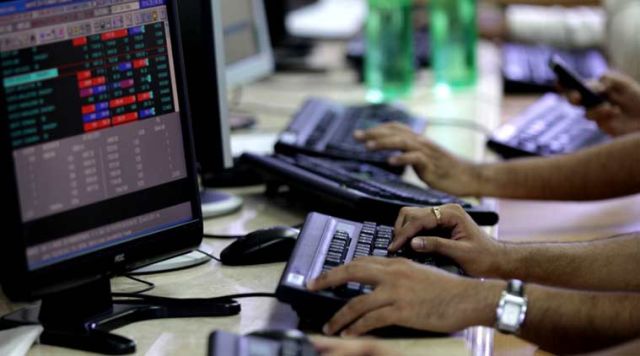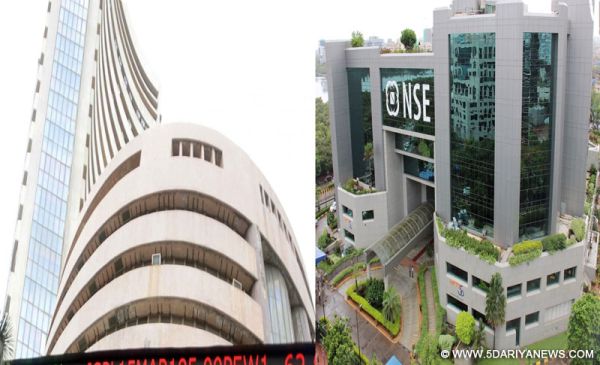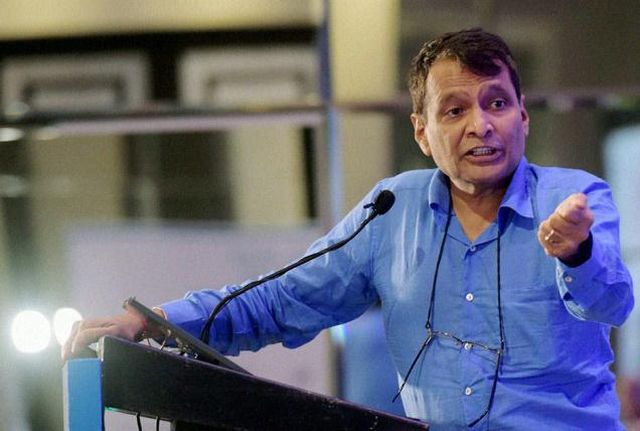
by admin | May 25, 2021 | Economy, Markets, News
 New Delhi : India’s Economic Survey for 2017-18 has pegged the country’s growth at 6.75 per cent for the current fiscal and 7 to 7.5 per cent for 2018-19.
New Delhi : India’s Economic Survey for 2017-18 has pegged the country’s growth at 6.75 per cent for the current fiscal and 7 to 7.5 per cent for 2018-19.
“A series of major reforms undertaken over the past year will allow real GDP growth to reach 6.75 per cent this fiscal and will rise to 7.0 to 7.5 percent in 2018-19, thereby re-instating India as the world’s fastest growing major economy,” the Survey said here on Monday.
The Survey, tabled in parliament by Finance Minister Arun Jaitley on Monday, also said the reform measures undertaken in 2017-18 can be strengthened further in 2018-19.
The Survey underlined that the economy began to accelerate in the second half of the year and can clock 6.75 per cent growth this fiscal due to the launch of transformational Goods and Services Tax reform on July 1, 2017 and resolution of the long-festering Twin Balance Sheet problem by sending the major stressed companies for resolution under the new Indian Bankruptcy Code.
It also said implementing a major recapitalisation package to strengthen the public sector banks, further liberalisation of foreign direct investment and the export uplift from the global recovery had played a major role in boosting the growth.
The Survey, however, pointed out that as per the quarterly estimates there was a reversal of the declining trend of GDP growth in the second quarter of 2017-18, led by the industry sector.
It said that India can be rated as among the best performing economies in the world as the average growth during last three years is around 4 percentage points higher than global growth and nearly 3 percentage points higher than that of emerging market and developing economies.
The survey cautioned some of the factors could have dampening effect on GDP growth in the coming year are like the possibility of an increase in crude oil prices in the international market.
—IANS

by admin | May 25, 2021 | Economy, Markets, News
 Mumbai : Optimism ahead of the tabling of the Economic Survey 2017-18 in Parliament, along with healthy buying in auto, metals and banking stocks, lifted the key Indian equity indices to trade at fresh high levels during the mid-afternoon trade session on Monday.
Mumbai : Optimism ahead of the tabling of the Economic Survey 2017-18 in Parliament, along with healthy buying in auto, metals and banking stocks, lifted the key Indian equity indices to trade at fresh high levels during the mid-afternoon trade session on Monday.
According to market observers, positive global cues, coupled with the expectation of sops from the Union Budget 2018-19, lifted investors’ risk-taking appetite.
Around 12.05 p.m., the wider Nifty50 of the National Stock Exchange traded higher by 88.95 points or 0.80 per cent at a fresh high of 11,158.60 points.
On the BSE, the barometer 30-scrip Sensitive Index (Sensex), which opened at 36,106.36 points, traded at a fresh level of 36,391.59 points — up 341.15 points or 0.95 per cent from its previous close.
The BSE market breadth was bullish as 1,308 stocks advanced against 1,298 declines.
During intra-day trade, the Nifty50 scaled a new high of 11,163.75 points and the Sensex of 36,410.60 points.
“Indian shares opened higher Monday on value buying amid increased risk appetite. Investors focus on economic survey and budget announcement later this week,” Dhruv Desai, Director and Chief Operating Officer of Tradebulls, told IANS.
“Both benchmark indices jumped to record high on continued institutional buying, particularly in car makers and metals stocks,” he added.
On the last trading session on Thursday, the equity indices had closed in the red on the back of heavy selling pressure in auto, IT and consumer durables stocks.
The Nifty50 fell by 16.35 points or 0.15 per cent to close at 11,069.65 points, while the Sensex closed at 36,050.44 points — down 111.20 points or 0.31 per cent.
—IANS

by admin | May 25, 2021 | Economy, Markets, News
 By Rohit Vaid,
By Rohit Vaid,
Mumbai : Announcements on capital expenditure, along with policy reforms and expected sops from the the Union Budget 2018-19, will determine the trajectory of the Indian equity markets in the coming week.
According to market observers, other themes for the trade week starting on January 29, will be macro-economic growth and select industrial production data points coupled with stock-specific movement due to the ongoing earnings result season.
“The budget remains critical, being the first one after GST (Goods and Services Tax) implementation and the last full year budget before the general elections in 2019,” Devendra Nevgi, Founder and Principal Partner, Delta Global Partners, told IANS.
“The balancing act for the Finance Minister on reining in the fiscal deficit, rural populism and growth-boosting measures (private capex) remain the key themes that will be watched closely.”
Parliament’s budget session will kick off with the presentation of the Economic Survey 2017-18 on Monday, January 29, followed by the Union Budget 2018-19 on February 1.
“With crude oil prices surging, fiscal deficit projections in the upcoming budget will be keenly watched. The budget is expected to dictate the future direction of markets from here on,” D.K. Aggarwal, Chairman and Managing Director of SMC Investments and Advisors, told IANS.
Apart from the budget, the week ahead will be heavily influenced by Q3 corporate earnings and the direction of foreign fund flows. Companies like HDFC, EIH, IndianOil, Piramal Enterprises, TVS Motor Company, ICICI Bank, L&T, NTPC, Vedanta, Titan Company, Bajaj Auto and Hindalco Industries are expected to announce their quarterly results in the coming week.
“Next week, till the Union Budget announcement, markets are expected to be driven by corporate earnings and the buoyant global markets as FPI (foreign portfolio investors) flows remain strong,” Nevgi said.
Besides quarterly results, macro-economic data points like GDP figures for 2017-18, Index of Eight Core Industries (ECI) figures and the country’s fiscal deficit data up to December will be keenly watched by investors.
In addition, monthly automobile sales figures and the Purchasing Managers’ Index (PMI) manufacturing and services data will become other major sentiment drivers.
On the currency front, the rupee’s strength will be arrested by higher crude oil prices, “as it will make rupee less attractive”.
“Next week, we expect USD/INR to trade within a range of 63.30 to 63.80. Rupee is expected to remain weak against the euro and pound,” Anindya Banerjee, Deputy Vice President for Currency and Interest Rates with Kotak Securities, told IANS.
The Indian currency had strengthened by 30 paise during the week ended January 25, to close at Rs 63.55 against the US dollar from its last week’s close at Rs 63.85.
In terms of technical charts, the underlying uptrend in the National Stock Exchange (NSE) Nifty is expected to continue.
“Technically, with the Nifty surging higher to new record highs, the underlying intermediate uptrend remains intact,” Deepak Jasani, Head – Retail Research, HDFC Securities, told IANS.
“Further upsides are likely once the immediate resistances of 11,110 points are taken out. Weakness could emerge if the supports of 10,881 points are broken.”
Last week, key indices made gains on the back of revival in corporate earnings, along with the country’s healthy economic growth outlook projected by the International Monetary Fund and massive inflow of foreign funds.
Consequently, the 30-scrip Sensitive Index (Sensex) of the Bombay Stock Exchange closed at 36,050.44 points — up 538.86 points or 1.52 per cent from its previous week’s close.
Similarly, the NSE Nifty closed higher by 174.95 points or 1.60 per cent to 11,069.65 points.
(Rohit Vaid can be contacted at rohit.v@ians.in)
—IANS

by admin | May 25, 2021 | Opinions

Uday Kotak
By Amit Kapoor,
Last week, Uday Kotak of Kotak Mahindra Bank had a warning about the stock markets entering a possible bubble. According to him, Indians are investing massive amounts of savings into “a few hundred stocks” of firms whose governance standards are questionable. The Bombay Stock Exchange (BSE) Sensex rose almost 28 percent in 2017 and the rally has continued in the new year. It is trading at prices that are over 26 times their underlying average earning per share. Even Uday Kotaks warning was not enough to break the general market trend (although mid-caps did face a correction soon after the red flag was raised, but other sectors more than compensated for it).
To put things in perspective, it must be pointed out that Reserve Bank of India (RBI) data shows that the pattern of household savings has drastically changed over the last year. In the decade-and-a-half between 2000-01 and 2015-16, household investment in shares averaged around Rs 226 billion and peaked at Rs 743 billion just before the crisis in 2007-08. However, in 2016-17, it jumped to a historical high of Rs 1,825 billion.
Demonetisation can be said to be the immediate trigger. Since holding cash is now seen as a risk, households have been looking at new avenues of parking their money. Even bank deposits have witnessed an abrupt jump over the last financial year. After gradually rising from Rs 1,000 billion to Rs 6,220 billion between 2000-01 and 2015-16, bank deposits almost reached Rs 11,000 billion in 2016-17.
So, the bottom line is that the average Indian saver is getting more and more invested into the stock market and so any significant downturns will have far-reaching implications. Therefore, Uday Kotak’s warnings need serious consideration and even more so because there are multiple global factors that can put an end to the bull markets.
First, the global economy began witnessing its first signs of recovery last year after the 2008 financial crisis. As a response to the crisis, central banks all over the world had began a policy of quantitative easing that pumped excess liquidity into global markets. The gains from this policy are debatable but the money found its way into financial assets and bloated their prices. Therefore, despite a lack of positive economic news and unexpected political changes throughout the world, equity markets continued to show an upward trend.
However, as economies continue to show signs of revival the quantitative easing policies will slowly come to an end and excess liquidity will be rolled back by central banks. The US Federal Reserve is already doing so, and other major economies will soon follow suit. This money will be withdrawn from the global equity markets which will, therefore, face an inevitable correction.
Second, the flip side of a change in liquidity is the interest rate level. In pursuit of the policy of quantitative easing, central banks in the advanced economies have reduced interest rates to rock bottom levels with Japan even going into sub-zero levels. However, as the liquidity taps are closed, interest rates will be raised to pre-crisis levels. If there are no recessionary signals this year, the US might raise interest rates three times to about 2 percent. This will be another strong reason for money to flow out of global equity markets into the safer havens of US bonds. Such trends will not be good news for investors in the Indian stock market.
Third, there are fears that the American dollar might become weak as China has indicated an inclination towards curtailing its purchases of US government bonds. Since China is the single-biggest foreign holder of US debt, a slowdown in its purchases would imply higher bond yields and a weaker dollar. This would result in a flight of capital to safety out of world markets, including that of India.
Finally, crude oil prices are expected to be high this year with the unrest in the Middle East. Prices are already above $60 a barrel and will continue its upward trend as the oil cartel tightens the market supply and US output of shale oil slows. Since oil prices are the leading drivers of inflation in the world, and especially in India, interest rates will also have to be raised commensurately. These two factors — inflation and rising interest rates — are highly inimical to company earnings and, hence, will have a significant negative impact on the markets.
There are numerous global factors that are poised to bring an end to the bull run in the stock markets and considering the fact that, historically, high levels of household savings have been invested in it, a forewarning is due so that investors are not caught unawares and overexposed. It is better to form bear market plans now when investors have ample time and a clear head.
(Amit Kapoor is chair, Institute for Competitiveness, India. He can be contacted at amit.kapoor@competitiveness.in and tweets @kautiliya. Chirag Yadav, researcher at Institute for Competitiveness has contributed to the article.)
—IANS

by admin | May 25, 2021 | Business Summit, Corporate, Corporate finance, Corporate Governance, Economy, Events, News, Politics

Suresh Prabhu
New Delhi : India is expected to become a $5 trillion economy in the next eight-nine years with the manufacturing sector alone contributing 20 per cent towards that, Union Commerce Minister Suresh Prabhu said on Wednesday.
“We are preparing a detailed plan towards achieving that. Experts are busy preparing the roadmap including all the sectors where manufacturing can be promoted. If manufacturing is digitised, it will create a huge opportunity for technology firms,” Prabhu said.
Speaking on the first day of the India Digital Summit organised by the Internet and Mobile Association of India (IAMAI) here, the minister said innnovation cannot be confined to geographical borders.
“In order to reach the $5 trillion economy, manufacturing will contrinute $1 trillion and services will contribute $3 trillion,” the minister told the gathering.
Prabhu said he was currently working on a strategy for international trade which will contribute $2 trillion to the economy, where the contribution can come both from manufacturing and services sectors.
Earlier in the day, Niti Aayog Chief Executive Amitabh Kant said that every Indian will have a smartphone in the next five years.
There were nearly 400 million smartphone users in the country, he said, adding this was a period of huge technology disruption in the country.
“Today, 85 per cent of the devices are still unconnected. Therefore, there is a huge opportunity in the Internet of Things (IoT) space. The opportunity would be in the range of $70 billion by 2025,” Kant told the gathering.
According to him, Artificial Intelligence (AI) alone will generate opportunity to the tune of $32 billion.
“Advanced robotics are already handling 25 per cent of the jobs. This will rise to 45 per cent in the coming years.
“India is already ranked globally as the most active Internet user globally on a monthly basis. Digital transaction will touch $100 trillion in the next 10 years,” he told the gathering.
With 99 per cent Aadhaar penetration and bank account opened under Jan Dhan Yojana, he said, the scope was immense for the Fin-Tech industry.
“As far as the start-up community goes, ‘Make in India’ initiative had brought in a paradigm change in the financial ecosystem. While we have 4,000 start-ups, it will go up to 12,000 by 2020,” Kant said, adding that about 600 start-ups were there in the FinTech sector which will become a $14 billion opportunity by 2020.
The challenges today for the country were to provide safe drinking water, create infrastructure and build flyovers. All these give unicorns a unique opportunity to invest and explore, Kant said.
Telecom Secretary Aruna Sundararajan said that for IoT to happen, we need to have a robust 4G ecosystem in the country.
“I am hopeful that by the end of this year, we will have a pan-India 4G network availability,” Sundararajan told the audience.
She mentioned that the government has constituted a task force for rolling out the 5G network in the country.
The taskforce will come out with a roadmap soon, she said, adding that the Department of Telecommunications is keen on partnering with key telecom providers in the roll-out stage.
Delivering the inaugural address, Rajan Anandan, Chairman, IAMAI, and Vice President, Google India and South-East Asia, said these are exciting times for the Internet adoption in the country.
“Availability of very low-cost yet high-speed mobile Internet connection in 2017 has moved a slow-speed nation to a high-speed nation,” Anandan noted.
—IANS

 New Delhi : India’s Economic Survey for 2017-18 has pegged the country’s growth at 6.75 per cent for the current fiscal and 7 to 7.5 per cent for 2018-19.
New Delhi : India’s Economic Survey for 2017-18 has pegged the country’s growth at 6.75 per cent for the current fiscal and 7 to 7.5 per cent for 2018-19.



